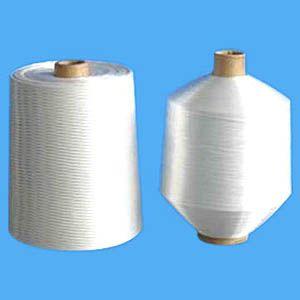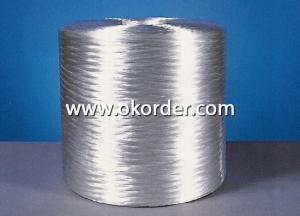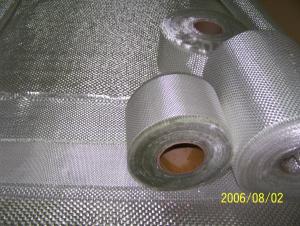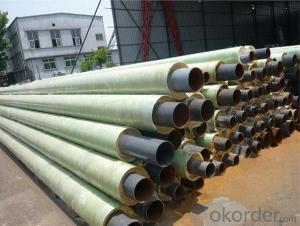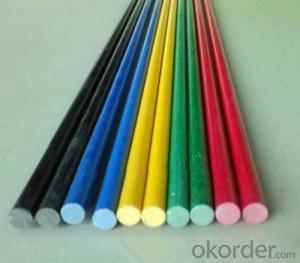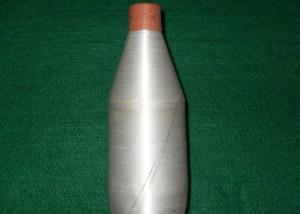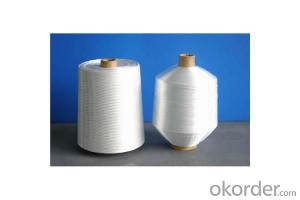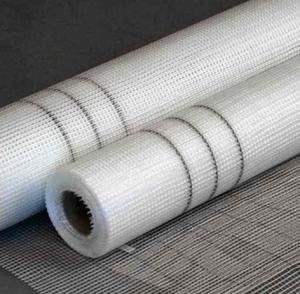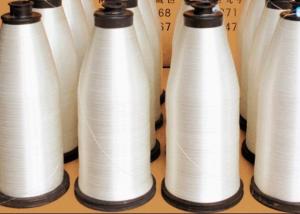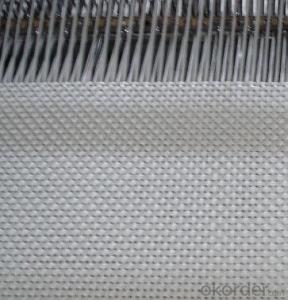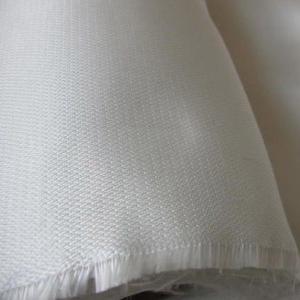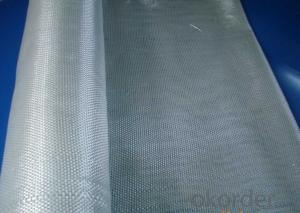Fiberglass Yarn
- Loading Port:
- China Main Port
- Payment Terms:
- TT or L/C
- Min Order Qty:
- 1Ton kg
- Supply Capability:
- 100000Kg/Month kg/month
OKorder Service Pledge
Quality Product, Order Online Tracking, Timely Delivery
OKorder Financial Service
Credit Rating, Credit Services, Credit Purchasing
You Might Also Like
Packaging & Delivery of Fiberglass Yarn
Specifications of Fiberglass Yarn
Glass fiber filament yarn
corrosion resistant, heat resistance
little moisture absorption
low thermal conductivity
Fiberglass yarn is made from 4-9um fiberglass filameters which are the gathered and twisted into one finished yarn. It is widely used in productions of fabric as finished well as electrical wrapping materials, engineering materials, textured yarn, woven electronic grade fabric and so on.
Packaging & Delivery of of Fiberglass Yarn
Packaging Detail: carton and pallet
Delivery Detail: within 15days after order placed
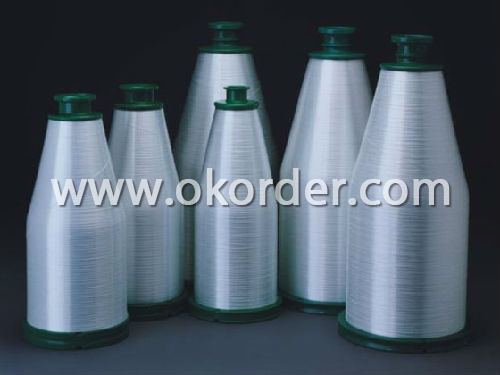
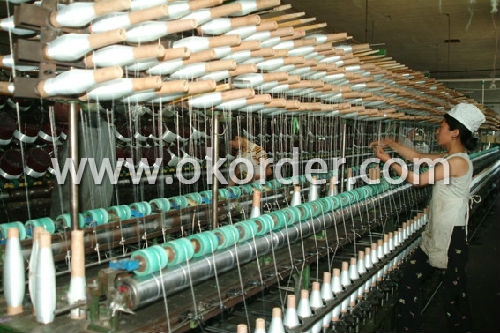
- Q:What are the different thicknesses of fiberglass yarn available?
- There are various thicknesses of fiberglass yarn available, ranging from thin and lightweight options to thicker and more robust variations.
- Q:Can fiberglass yarn be used for making socks?
- No, fiberglass yarn cannot be used for making socks. Fiberglass yarn is typically used in industries such as insulation, aerospace, and construction due to its high strength and heat resistance properties. However, it is not suitable for making clothing items like socks as it is not flexible or comfortable to wear. Socks need to have stretch and be soft against the skin, which fiberglass yarn cannot provide. Therefore, other materials such as cotton, wool, or synthetic fibers like nylon or polyester are commonly used for making socks.
- Q:What are the common adhesives or binders used with fiberglass yarn?
- There are several common adhesives or binders used with fiberglass yarn, depending on the specific application or desired properties of the final product. One of the most commonly used adhesives is epoxy resin. Epoxy resin offers excellent bonding strength and provides high resistance to chemicals, heat, and moisture. It is widely used in various industries, including aerospace, automotive, and construction. Polyester resin is another commonly used adhesive for fiberglass yarn. It is known for its cost-effectiveness, ease of use, and good adhesion properties. Polyester resin is often used in applications such as boat building, automotive parts, and electrical insulation. Vinyl ester resin is a third option for bonding fiberglass yarn. It offers superior chemical resistance compared to polyester resin, making it suitable for applications where exposure to harsh chemicals is expected. Vinyl ester resin is commonly used in chemical storage tanks, pipes, and corrosion-resistant structures. In addition to these resins, other adhesives like cyanoacrylate (super glue) or polyurethane can also be used with fiberglass yarn, depending on the specific requirements of the project. These adhesives provide different properties such as fast curing times, flexibility, or increased adhesion strength. It is important to note that the choice of adhesive or binder depends on factors such as the intended use of the fiberglass yarn, the desired strength and durability, as well as any environmental or chemical exposure the final product may be subjected to. Therefore, it is advisable to consult with experts or manufacturers to determine the most suitable adhesive for a specific fiberglass yarn application.
- Q:Is fiberglass yarn resistant to pests or insects?
- Indeed, pests and insects are highly thwarted by fiberglass yarn due to its remarkable resistance. This material is crafted from spun glass fibers that create an inhospitable habitat for these unwanted creatures. Insects find fiberglass yarn unappealing because it lacks the organic matter they usually rely on for sustenance. Furthermore, the sleek and slick surface of the fiberglass yarn poses a challenge for pests attempting to crawl or burrow into it. Consequently, fiberglass yarn emerges as an outstanding option for endeavors requiring pest and insect resilience, such as the fabrication of screens, insulation, and textiles.
- Q:Is fiberglass yarn resistant to rot?
- Yes, fiberglass yarn is resistant to rot.
- Q:Is fiberglass yarn biodegradable or recyclable?
- Fiberglass yarn is not biodegradable, meaning it cannot be broken down naturally by living organisms into simpler, organic materials. However, it is recyclable. Fiberglass yarn can be melted down and reused to create new fiberglass products. Recycling fiberglass yarn helps reduce waste and conserve resources, making it a more environmentally-friendly option compared to disposal in landfills.
- Q:Is fiberglass yarn safe for human use?
- When handled and used correctly, fiberglass yarn can be safe for human use in suitable applications. Fiberglass is a versatile and durable material that finds wide usage in industries like construction, insulation, and textiles. It is renowned for its strength, heat resistance, and insulating properties. Nevertheless, it is crucial to be aware that mishandling fiberglass can result in potential health risks. Fiberglass yarn consists of small glass fibers that can become airborne when disturbed, and inhaling these fibers can cause irritation to the respiratory system and potentially lead to health problems like coughing, sneezing, and skin irritation. To ensure human safety, it is of utmost importance to adhere to proper safety measures when working with fiberglass yarn. This includes wearing protective clothing, such as gloves and masks, to prevent direct contact with the skin and inhalation of the fibers. Adequate ventilation is also crucial to minimize the concentration of airborne fibers. Furthermore, fiberglass yarn should be utilized in suitable applications where the risk of fiber release is minimal, such as in the production of reinforced plastics, textiles, or non-woven fabrics. In these instances, the fiberglass is typically encapsulated or coated, reducing the chance of fiber release and enhancing its safety for human use. In conclusion, fiberglass yarn can be safe for human use if handled and applied correctly. However, it is essential to take necessary precautions to reduce exposure to airborne fibers and ensure a safe working environment.
- Q:How does fiberglass yarn affect the acoustic properties of a product?
- Fiberglass yarn plays a significant role in modifying the acoustic properties of a product. Due to its unique composition and structure, fiberglass yarn can effectively control and manipulate sound waves, resulting in improved acoustic performance. One of the main advantages of fiberglass yarn is its high density and rigidity, which contributes to its excellent sound absorption capabilities. When used in products such as acoustic panels, insulation materials, or soundproofing barriers, fiberglass yarn helps to reduce and dampen noise by absorbing sound energy. This absorption occurs as sound waves pass through the product, causing the fiberglass yarn to vibrate and convert the sound energy into heat energy. Moreover, the composition of fiberglass yarn allows for effective sound insulation. It acts as a barrier to prevent the transmission of sound waves from one area to another. This is particularly useful in applications such as building insulation or automotive components, where the goal is to minimize the transfer of noise from outside sources. Additionally, fiberglass yarn can enhance the overall acoustics of a product by improving its sound reflection and diffusion properties. By strategically placing fiberglass yarn within a product, it can help to scatter and disperse sound waves more evenly, reducing the occurrence of echoes, reverberation, or standing waves. This is especially important in spaces such as concert halls, recording studios, or home theaters, where optimal sound quality and clarity are desired. In summary, fiberglass yarn greatly influences the acoustic properties of a product by providing sound absorption, insulation, and reflection/diffusion capabilities. Its ability to control and manipulate sound waves makes it a valuable component for various applications, ultimately leading to improved acoustic performance.
- Q:What are the different deniers available for fiberglass yarn?
- There are several different deniers available for fiberglass yarn, which refer to the thickness or fineness of the individual fibers within the yarn. Some common deniers for fiberglass yarn include 300D, 600D, and 1200D. The denier of fiberglass yarn is determined by the weight in grams of 9000 meters of the yarn. A lower denier such as 300D indicates a finer and lighter yarn, while a higher denier like 1200D suggests a thicker and heavier yarn. The choice of denier for fiberglass yarn depends on the specific application and desired properties. A finer denier may be suitable for applications that require flexibility, softness, and a smoother appearance. On the other hand, a higher denier yarn may be preferred for applications that require strength, durability, and resistance to abrasion. It's important to note that the denier of fiberglass yarn can also affect its other characteristics, such as tensile strength, heat resistance, and electrical conductivity. Therefore, when selecting a denier for fiberglass yarn, it is crucial to consider the specific requirements of the intended use to ensure optimal performance.
- Q:Is fiberglass yarn resistant to mechanical damage?
- Yes, fiberglass yarn is known for its high resistance to mechanical damage. Fiberglass is a strong and durable material that is commonly used in applications where mechanical strength is crucial. It has excellent resistance to abrasion, impact, and tearing, making it highly resistant to mechanical damage. This makes fiberglass yarn suitable for various industries and applications, such as reinforcements in composites, insulation materials, textiles, and reinforcement in automotive and aerospace industries. Additionally, fiberglass yarn also exhibits good dimensional stability, even under extreme conditions, further enhancing its resistance to mechanical damage.
The products include textile yarn and a wide variety of reinforcement materials such as E-glassfiber roving, mat (emulsion/powder), woven roving, multi-axial fabric, chopped strand long fiber thermoplastics (C. S-TP, LFT), and other products.
1. Manufacturer Overview |
|
|---|---|
| Location | Chongqing, China |
| Year Established | 1971 |
| Annual Output Value | Above US$ 50 Million |
| Main Markets | North America, Eastern Europe, Southeast Asia, Mid East, Eastern Asia |
| Company Certifications | ISO9001 |
2. Manufacturer Certificates |
|
|---|---|
| a) Certification Name | |
| Range | |
| Reference | |
| Validity Period | |
3. Manufacturer Capability |
|
|---|---|
| a)Trade Capacity | |
| Nearest Port | Chongqing |
| Export Percentage | 40%-50% |
| No.of Employees in Trade Department | 21-50 People |
| Language Spoken: | English |
| b)Factory Information | |
| Factory Size: | Above 2000,000 square meters |
| No. of Production Lines | Above 4 |
| Contract Manufacturing | |
| Product Price Range | Average |
Send your message to us
Fiberglass Yarn
- Loading Port:
- China Main Port
- Payment Terms:
- TT or L/C
- Min Order Qty:
- 1Ton kg
- Supply Capability:
- 100000Kg/Month kg/month
OKorder Service Pledge
Quality Product, Order Online Tracking, Timely Delivery
OKorder Financial Service
Credit Rating, Credit Services, Credit Purchasing
Similar products
New products
Hot products
Related keywords
